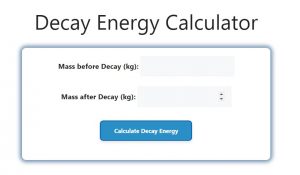About Decay Energy Calculator (Formula)
Decay energy is the energy released during the radioactive decay of a particle. This energy can be calculated by considering the difference in mass before and after the decay process. Understanding decay energy is essential in fields such as nuclear physics and radiation therapy. The Decay Energy Calculator simplifies this complex calculation, providing a quick and accurate way to find the energy released during decay.
Formula
The formula for calculating decay energy is derived from Einstein’s famous equation, E = mc², and is given as:
Decay Energy (E) = (Mass before Decay – Mass after Decay) * c²
Where:
- E is the decay energy in joules,
- Mass before Decay is the mass of the particle before decay (in kilograms),
- Mass after Decay is the mass of the particle after decay (in kilograms),
- c is the speed of light (approximately 3.00 × 10^8 m/s).
How to Use
To use the Decay Energy Calculator, follow these simple steps:
- Enter the mass before decay (in kilograms).
- Enter the mass after decay (in kilograms).
- The calculator applies the formula: (Mass before Decay – Mass after Decay) * c².
- The result will show the decay energy in joules.
This process helps you quickly determine the energy released during particle decay.
Example
Suppose you are calculating the decay energy of a particle with the following values:
- Mass before Decay: 2.5 × 10^-27 kg,
- Mass after Decay: 2.4 × 10^-27 kg.
- Input the values into the formula:
Decay Energy (E) = (2.5 × 10^-27 – 2.4 × 10^-27) * (3.00 × 10^8)². - Decay Energy (E) = (0.1 × 10^-27) * 9 × 10^16.
- Decay Energy (E) = 9 × 10^-12 joules.
Thus, the energy released during the decay is 9 × 10^-12 joules.

FAQs
- What is decay energy?
Decay energy is the energy released during the process of radioactive decay. - Why is decay energy important?
Decay energy is crucial for understanding the behavior of radioactive particles and is used in nuclear physics, medicine, and energy applications. - How is decay energy calculated?
Decay energy is calculated using the formula: Decay Energy = (Mass before Decay – Mass after Decay) * c². - What units are used to measure decay energy?
Decay energy is typically measured in joules. - What is the speed of light constant (c)?
The speed of light constant, c, is approximately 3.00 × 10^8 meters per second. - Why is the speed of light used in the formula?
The speed of light is used in the formula because decay energy is derived from Einstein’s equation E = mc², which links mass and energy. - Can I use this calculator for any type of radioactive decay?
Yes, the Decay Energy Calculator can be used for any type of radioactive decay, provided you have the mass before and after decay. - Is the decay energy always positive?
Yes, the decay energy is always positive, as energy is released during the decay process. - What happens to the mass after decay?
After decay, part of the mass is converted into energy, which is released during the process. - Is decay energy the same as binding energy?
No, decay energy refers to the energy released during decay, while binding energy refers to the energy required to hold the nucleus together. - Can this formula be used for nuclear fission?
Yes, the formula can be applied to nuclear fission processes, where a heavy nucleus splits into lighter nuclei, releasing energy. - How accurate is the Decay Energy Calculator?
The Decay Energy Calculator is highly accurate, provided the mass values are entered correctly. - Can the calculator handle very small mass differences?
Yes, the calculator is designed to handle small mass differences, as commonly seen in atomic and nuclear decay. - How do I know the mass before and after decay?
These values are typically measured or provided in scientific data related to the decay process. - What is the typical range of decay energies?
Decay energies can range from very small values, such as in atomic decays, to much larger values, such as in nuclear reactions. - Can I calculate the energy for different particles?
Yes, the Decay Energy Calculator works for different particles as long as you provide the correct mass values. - Is this calculator useful in medical applications?
Yes, the decay energy calculation is crucial in medical fields, particularly in radiation therapy for cancer treatment. - Can this formula be applied to antimatter decay?
Yes, the formula can be used for antimatter decay, as the energy release follows the same principles of mass and energy conversion. - Is this calculator suitable for classroom use?
Absolutely. The Decay Energy Calculator is a great educational tool for students learning about nuclear physics and energy. - How does decay energy relate to nuclear power?
In nuclear power, decay energy is one of the forms of energy released from radioactive materials, contributing to the overall energy output.
Conclusion
The Decay Energy Calculator is an essential tool for accurately calculating the energy released during radioactive decay. By using the formula (Mass before Decay – Mass after Decay) * c², you can easily determine the decay energy, which has applications in nuclear physics, medicine, and energy production. This calculator simplifies the process, ensuring fast and reliable results for both professionals and students alike.